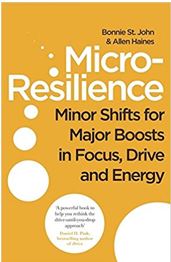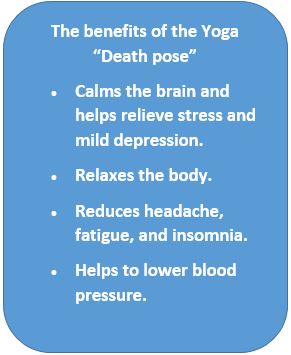Blog Post No. 46
31st March 2017
Copyright © Renata Taylor-Byrne 2017
Renata’s Coaching & Counselling blog: Daily resilience–boosters for you
Introduction
Do you want to be more resilient? To stand up to the pressures of your daily life more vigorously and powerfully and energetically?
 In this blog I am going to summarise some findings from research conducted on athletes, which can help us build our resilience in the face of all the hassles and challenges we can face at work each day.
In this blog I am going to summarise some findings from research conducted on athletes, which can help us build our resilience in the face of all the hassles and challenges we can face at work each day.
An explanation of micro-resilience at work
 Bonnie St. John and Allen Haines wrote a book called ‘Micro-resilience’, and in it they summarise this research finding: Dr James Loehr (a sports psychologist) wanted to understand why there were hundreds of athletes who were on international tours, but there were only a few who regularly won the tournaments and trophies. He wanted to know what the difference was between these two sets of athletes.
Bonnie St. John and Allen Haines wrote a book called ‘Micro-resilience’, and in it they summarise this research finding: Dr James Loehr (a sports psychologist) wanted to understand why there were hundreds of athletes who were on international tours, but there were only a few who regularly won the tournaments and trophies. He wanted to know what the difference was between these two sets of athletes.
Loehr put heart rate monitors on a selection of the two different sets of tennis players – the ‘winners’ and the ‘also ran’s’ – and discovered that the top tennis players were able to very speedily recover their energy and positive focus after having played shots.
As they were returning to the baseline in the tennis court, or to the side of the court, they used particular strategies to recover their energy, focus and motivation.
These top-players very quickly returned their heart rates to normal – much more quickly than their less successful competitors. Here was the crucial part of what Dr James Loehr learned:
“The further he went down the list of seeded players, the more dramatic the differences were. Those at the bottom of the list (the less successful tennis players) employed none of these rejuvenating behaviours….”
“They stayed keyed up, tense and even distracted in the sixteen to twenty seconds that normally elapse between a point scored and the following serve.”
The power of ‘mini-recoveries’
He discovered that by the final set of a 3 hour tennis match, the player who had been using small, imperceptible ‘mini-recoveries’ in-between the points, was much more likely to succeed in the tennis game than the players who did not use such strategies.
So Dr Loehr created something called the ’16 second cure’ and this consists of focusing exercises and relaxation techniques that help the players, who are under intense pressure, to do the following things:
“…shake off mistakes, release tension, and project a positive image to their opponents…”
And this strategy has now been taught by tennis coaches throughout the world.
How this research finding can help people in all types of jobs
We can all use this research insight in any field of work. Each day, any of us can experience periods of intense pressure, quiet times and a whole range of experiences in-between. We also have a constantly changing selection of people to deal with and respond to. How can we keep going so that we aren’t totally washed out by the end of the working day?
 Dr James Loehr created the concept of the ‘executive athlete’ after these research findings, which he wrote about in his book ‘The Power of Full Engagement’ (2003) with T. Schwartz.
Dr James Loehr created the concept of the ‘executive athlete’ after these research findings, which he wrote about in his book ‘The Power of Full Engagement’ (2003) with T. Schwartz.
This very successful use of energy management strategies by athletes can be transferred to other working environments, if we adapt them appropriately.
Micro-resilience techniques to help us stay in control
If you experiment with using some of these strategies – listed below – to keep you going during the day, you will find that your energy level is higher and you won’t feel as drained.
I used these techniques during my career as a college tutor, and there are also techniques from Bonnie St. John and Allen Haines’s book. (Bear in mind that if you are working in exploitative work situations, you will need help from your union as well as these self-management strategies. The union’s specialist form of protection is necessary as it will be beyond your capacity to fully defend yourself if your energies are drained from: bullying management tactics; zero hours contracts; wages below the minimum wage, and/or unhealthy work environments).
Here is a little selection of just seven such strategies; and I teach many more to my coaching-counselling clients:
1. The Yoga ‘Death pose’
 First, let us look at the ‘death pose’ from yoga practice. This is an amazingly effective way to recharge your batteries, and is very good for your back. If you have you own office or there is a vacant room, simply lie on the floor for 10 minutes with a book (of, say, two inches thickness) under your head (as a ‘hard pillow’). Put your arms down by your sides. Clear your mind of any stress or strain, worry or preoccupation. Breathe deeply into your belly, and relax. Stay still, and close your eyes if you want to. Any ideas that arise in your mind should be gently brushed away. After 10 minutes, very slowly sit up, and then stand up. This will refresh your body and mind at the same time.
First, let us look at the ‘death pose’ from yoga practice. This is an amazingly effective way to recharge your batteries, and is very good for your back. If you have you own office or there is a vacant room, simply lie on the floor for 10 minutes with a book (of, say, two inches thickness) under your head (as a ‘hard pillow’). Put your arms down by your sides. Clear your mind of any stress or strain, worry or preoccupation. Breathe deeply into your belly, and relax. Stay still, and close your eyes if you want to. Any ideas that arise in your mind should be gently brushed away. After 10 minutes, very slowly sit up, and then stand up. This will refresh your body and mind at the same time.

2.The seated Tin Soldier/Rag Doll Relaxation Exercise
Whilst sitting at your desk, after about 30 or 40 minutes of intense concentration, you will need a break. Sometimes you will need to get up and move around (as sedentary activity is very bad for you, physically and mentally!). But sometimes you can relax while you are sitting down. One way to do that is to use the ‘Tin soldier/Rag doll’ exercise. This is how it goes:
Tense your body, arms, and face as much as possible for a couple of minutes. Really feel the tension in your body. Imagine you are made of tin, and are very stiff and unbending. (The ‘tin soldier’ phase).
Then slowly, slowly let all the tension drain out of your body, and change yourself into a rag doll. Feel yourself melt into the chair. Relax all your muscles – your thigh muscles, feet, arms, hands and fingers, stomach and jaw, and facial muscles. Let your arms hang down by your sides. Let your head fall, and your shoulder slump. (The ‘rag doll’ phase).
Sit with the feeling of complete relaxation for a few minutes (say, five or six). This will be really good for your body and mind – to say nothing of your productivity, creativity and focus. In the process, you will be switching on your ‘relaxation response’ which is (to get a bit technical) the parasympathetic branch of your nervous system.
3. Have a quick, healthy snack to boost your blood sugar level.
By eating a small amount of nuts and seeds (for example) you boost your blood sugar level which helps with willpower, and energy during late morning or late afternoon meetings or other challenges.
~~~~
4. Have a short walk
Get out of the building, to change your environment. Just a ten minute walk will put you in a different space (mentally), but in particular, it’s really valuable to get out at dinnertime (lunchtime). You will feel mentally refreshed and have more energy for your work in the afternoon. Seeing trees and experiencing fresh air will boost your energy. Recent research shows that taking a stroll through a natural setting can boost performance on “tasks calling for sustained focus”: “Taking in the sights and sounds of nature appears to be especially beneficial for our minds.”
5. Write it Out!
If you’ve had a draining, difficult interaction with someone in work, and you are still reverberating from it, then when you are at your desk (or workstation), write down what happened and how you felt about it. Writing it down will get it out of your head and give you a chance to cool down. Later you can then reflect on what happened.
(If you are unable to write anything down, simply name the emotions that you are going through, in your mind.) This is a technique that is called “labelling” and there is a New England head teacher (whom St John and Haines describe in their book) who uses this technique when she has confrontations with parents and teachers.
“When she tried labelling, Kathleen noticed that it increased her sense of control. Now, unbeknownst to her guests, Kathleen’s notes during confrontational meetings not only cover action steps and follow-up items but also descriptions of her emotions during each encounter.”
Dr Daniel Amen, who is an expert on brain-scanning techniques, says: “Often, just naming a thought takes away its power”.
Or as Dr Daniel Siegel says: “You have to name it to tame it!”
~~~
6. Using your sense of smell

Scents are very powerful. Dr Joan Borysenko, who was one of the pioneers of integrative medicine and worked at Harvard medical school, stated: “Certain scents can cut right through an emotional hijack. For example, cinnamon, vanilla and nutmeg.” These scents affect our limbic system and relax us very quickly. This finding was confirmed by Dr Daniel Amen, in his book ‘Change your brain, change your life’:
“Because your sense of smell goes directly to the deep limbic system, it is easy to see why smells can have such a powerful impact on our feeling states. The right smells likely cool the limbic system. Pleasing fragrances are like an anti-inflammatory”.
So, having small samples of spices, perfumes or sweets, in your work environment, which have really comforting associations for you, can give you a quick boost of energy.

7. Images from nature can calm us down
Finally, having pictures of scenes from nature around us will have a beneficial effect on us, even if they are just on our screensaver or on a poster on the wall. Or in a frame on our desk or workstation. Just looking at photos of nature in a quiet room can give us a greater mental boost than walking down a busy urban street.
Dr Marc Berman and researchers at the University of Michigan had participants take a break for 10 minutes in a quiet room to look at pictures of a nature scene or city street. They found that mental performance improved after the nature break, even though the images were only on paper. Although the boost wasn’t as great as when participants actually took a walk among the trees, it was more effective than an actual city walk.
Conclusion
Balancing our stressful working days with micro-resilience techniques- like the seven outlined above – will make us happier, increase our energy, and improve the quality of our lives.
Why not experiment with them, and see if any of them work for you!
If I had more time and space I could teach lots more of this stuff to you.
Best wishes
Renata
Renata Taylor-Byrne
Lifestyle Coach-Counsellor
ABC Coaching-Counselling Division
Telephone: 01422 843 629
Email: renata@abc-counselling.org
~~~
References
Loehr, J and Schwartz, T (2003) The Power of Full Engagement. New York. Simon and Shuster.
St John, Bonnie and Haines, Allen (2017) Micro-Resilience: Minor shifts for Major Boosts in Focus, Drive and Energy. London. Piatkus.
~~~
